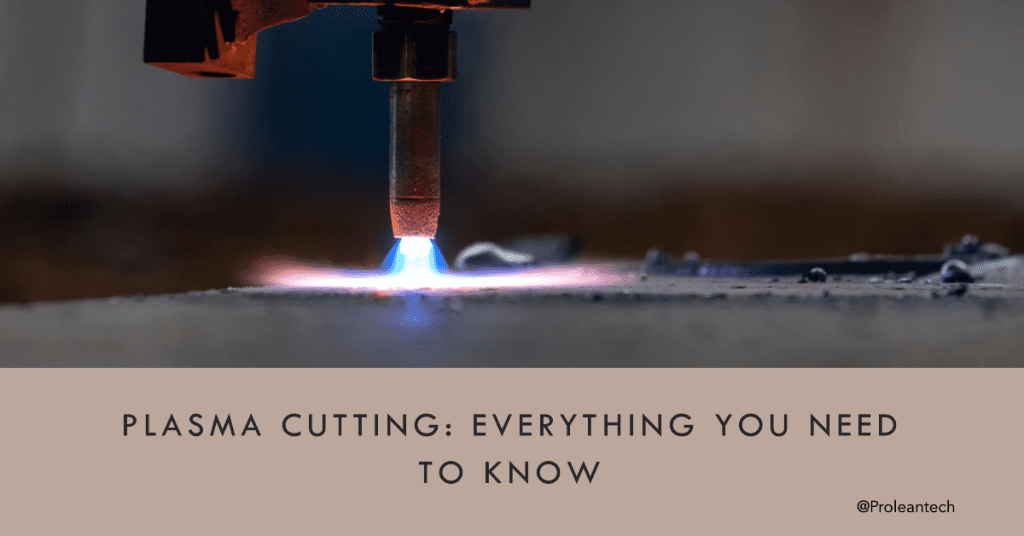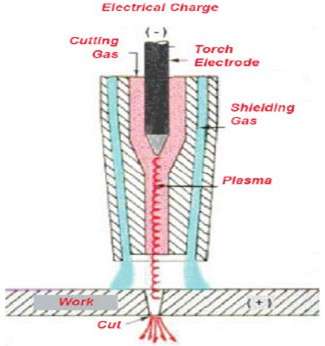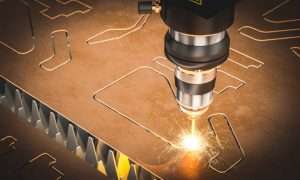
Plasma cutting is one of the accurate cutting approaches, which uses ionized gas (called plasma) to cut any profile through conductive metals. The common material that can be cut with plasma arc includes iron, stainless steel, copper, brass, titanium, and other conductive metal & alloys. This article will discuss plasma, the plasma-cutting process, advantages, disadvantages, applications, and other aspects.
What is plasma?
Plasma is the highest thermal state of matter, which comes after solids, liquids, and gas. When gases are heated at 11,000° – 30,000° C, it converts into plasma. The gas used in plasma cutter can be compressed air, oxygen, nitrogen, argon, hydrogen, or any combination of these.
The Plasma-cutting Process
As plasma cutting is a thermal approach, it uses a strict beam of high-temperature plasma. At the same time, a nozzle-like structure accomplishes the task of targeting of cutting spot with a highly concentrated plasma beam. The handling of plasma guns could be done manually or automated. For example, advanced plasma cutting technology like CNC can perform plasma cutting according to the uploaded design and computer instructions.
Working Principle of Plasma Cutting
Working principle (Hatala)
The creation of plasma is achieved by passing electric are in the gases (Nitrogen, argon, hydrogen). When an electric arc heats the gas, molecules gain energy and move randomly, resulting in the collision of atoms. The collision separates the balance electron and forms ions. The equilibrium of ionized particles in gas creates plasma. The compressed air pushes the plasma forcefully toward the opening of the nozzle in the form of a constricted beam.
The plasma gun (or plasma torch) consists of the electrode above the nozzle, which provides the electric Arc to the gas after being connected to the power source. In addition, a cooling system cools the plasma gun via gas or water.
Components of Plasma Cutter
There are three major components of plasma cutter equipment; a Power source, an Arc starting console, and a Plasma torch.
| Component | Description |
| Power Source | Power source refers to Electrical supply, a constant supply DC source. The role of the power source is to provide a continuous electrical supply during the cut period. |
| Starting Console for Arc | It is responsible for spark generation (inside the torch). The electric energy is transformed into a spark, which creates a plasma arc. |
| Plasma Torch | It is the element that serves as a guide for cutting alignment. Additionally, a cooling system and other consumables are included in the plasma torch. |
Common plasma cutting mistakes & how to avoid them?
Minor mistakes during the plasma cutting process can lead to various quality defects and material wastage. Let’s see some of the typical plasma-cutting mistakes and avoiding strategy.
- Low pierce height
You must set the pierce height and cut height in the control system. The low pierce height causes the melting of the plasma torch. It also results in the misfire and consumable damage to the process.
- Inappropriate cutting speed
Fluctuation in the cutting speed affects material consumption, resulting in decreased quality. Either the cutting rate is too slow, or too fast, the dimensional stability of the cut will be disturbed.
- Gas and content flow
Any disturbance in the pre-defined gas and content flow affects cut quality. It is recommended to frequently monitor gas flow, coolant flow, and other operating parameters.
- Inappropriate consumable
There are different consumables in the plasma torch assembly, such as an electrode, nozzle, shield cap, and swirl ring. These consumable needs to choose based on the thickness of the workpiece, material, and required specifications.
Advantages
- Thick metal sheets
The thickness of the workpiece that a plasma cutting technology handle is a significant advantage. It can cut medium-thick steel, copper, brass, aluminum, and other high-conductive metal & alloys. It is compatible with up to 100mm. However, the upper range for steel is 25 mm for accurate cutting.
- Complex shapes

CNC plasma cutter performing complex cut
A high degree of accuracy can be maintained with plasma cutting with complex shapes and profiles. The heated plasma consumes less material during thermal cutting and removes the excess material itself.
Plasma cutting is your most excellent option if your design includes complex geometries like curves, intersecting cuts, or any strange shape. Think of it as a pencil drawing on metal sheets.
- Safe handling
Since the plasma cutting utilizes inert gases, there is negligible risk of accidental ignition. It is much safer if you compare it to other thermal cutting methods, like the oxy-fuel approach.
- Material options
Plasma cutter works well with a broad range of manufacturing materials, such as carbon steel, stainless steel, mild steel, copper, aluminum, and titanium(related processing techniques include plasma cutting stainless, plasma cutting titanium, plasma cutting aluminum, and so on). It is capable of making intricate cuts in these materials.
- Small kerf
The cutting kerf is a limitation for blade-based cutting techniques, while the thermal cutting of plasma leaves a significantly smaller cutting kerf.
- High cutting speed
The cutting speed of plasma ranges from 350 to 800 mm/min (Plasma Pipe Cutting – the basics). It is one of the quickest metal-cutting methods, and the high cutting speed reduces the chance of metal abrasion.
Disadvantages
Since plasma cutting can cut medium-thick conductive metal & alloys, it cannot cut highly dense and thick material, such as chromium. Converting the size of blocks and rods is not possible with plasma cutting.
- Harmful fumes
The thermal cutting processes are associated with the generation of fumes, and plasma cutting is not an exceptional case. The operating condition of excessive temperature creates noise and fumes, demanding the Dell-designed ventilation systems. Inappropriate handling of fumes can cause health issues.
Applications
The application of plasma cutting extends across various industries including automotive, aerospace, industrial construction, shipbuilding, and more. Let’s discuss this in detail.
- Automotive
Plasma cutting is frequently utilized in the automotive industry for assembly, repair, and creation of several parts such as the floor, roof, interior, and many more.
- Aircrafts
In the aircraft industry, plasma cutters are used to cut, shape, and weld various parts. It offers accurate cuts and profiles for many defense aircraft, commercial planes, and military helicopters.
- Industrial constructions
Installation of various mechanical equipment requires shaping, cutting, and joining metallic components. Therefore, Plasma cutting has a significant role in industrial construction. In addition, it is also capable of salvage and scrapping operations.
- Quick & accurate piercing
The constricted beam of plasma does the piercing operation very accurately. While other conventional approaches take up to 30 seconds, it can be accomplished in two seconds with plasma cutting.
- Shipbuilding
Plasma cutting is used in the construction of Decks, interiors, housing, pressure vessels, engine box, and many more. Besides the above application, plasma cutting is widely used in the following applications;
- General & engineering machinery
- Chemical industry
- Nuclear industry
- Oil & gas
- Food processing
- Defense
Why go for plasma cutting?
If you compare plasma cutting with a laser(plasma vs laser cutting), water jet, or other conventional cutting approaches, it is effective in many aspects.
| Aspects | Plasma arc | Laser | Water-jet |
| Compatible materials | All High conductive metals & alloys | All metal & alloys, some plastics | Almost all materials ( Except Diamond) |
| Cost | Cost-effective | High cost than a plasma arc | Cost-effective |
| Accuracy | Tolerance as low as ±0.015 mm | As low as ± 0.001 mm of tolerance | As low as ± 0.15 mm. |
| Cutting speed | 35 cm/m | 200cm/s | 50cm/m |
We can conclude that plasma cutting is the go-to method for cutting medium-thick conductive metal & alloys with a high degree of accuracy. It is more cost-effective than laser cutting and more precise than water-jet cutting. It provides sufficient cutting speed when compared with the other two. Furthermore, plasma-cutting technology is also an energy-efficient approach.
Conclusion
Undoubtedly, CNC plasma cutting is ideal for medium-thick conductive metal & alloys. It offers high-precision cutting at a competitive price.
Many factors affect the quality of cuts, including operator skills, automation, and selection of control parameters. The quality results in demand fixing consumables according to the specification of the required cut.
Prolean has all the expertise required for your CNC plasma cutting service. We provide the service through a CNC plasma cutter with an automated plasma torch. If you need plasma cutting or any other fabrication service, please feel free to contact us.
FAQ’s
What is plasma cutting?
Plasma cutting is a thermal cutting process that uses a concentrated plasma arc, which melts the material from the cutting spot to create the cut or profile.
Which material can be cut with plasma cutters?
Plasma cutters can cut metal & alloys having high electrical conductivity, such as copper, steel, titanium, aluminum, and many more. In addition, it is compatible with up to medium thickness (100 mm).
What are the reasons for choosing plasma cutting technology?
Plasma-cutting technology offers high precision, complex cuts, high production speed, safe handling, and many more advantages.
What are the three components of a plasma arc cutter?
Three components of the plasma arc include a Power source, an Arc starting console, and a Plasma torch. The power source provides the supply. The Arc starting console deals with the arc generation & ionization of gas, and the plasma torch is responsible for supplying concentrated plasma beams and handling consumables.
Bibliography
- Hatala, M. (n.d.). THE PRINCIPLE OF PLASMA CUTTING TECHNOLOGY AND SIXFOLD PLASMA CUTTING. 5th INTERNATIONAL MULTIDISCIPLINARY CONFERENCE.
- (n.d.). Plasma Pipe Cutting – the basics. HGG Group.




0 Comments